The Witnesses to Captain. Brown’s Attack
Captain LeBoutillier had expended all his ammunition in the fight and was on his way back to Bertangles. Like most seasoned pilots who
[1] Whitham had read the historian, H A Jones’s, words that Richthofen was probably hit as lie chased May, by Brown who died and attacked between Sailly le-Sec and Vaux-sur-Somine.
 survived the war, and the coincidence is not accidental, he kept a sharp look-out at all times and in all directions. Down to his right nearVaux, he saw three aeroplanes; a Camel, followed by a Triplane — both heading west; then a second Camel, higher up, diving at about a 45° angle to intercept the Triplane. Taking a good look round every few seconds and turning his own Camel as required to be sure that no enemy was sneaking up on him, he watched the show from a front row seat in the Gallery.
survived the war, and the coincidence is not accidental, he kept a sharp look-out at all times and in all directions. Down to his right nearVaux, he saw three aeroplanes; a Camel, followed by a Triplane — both heading west; then a second Camel, higher up, diving at about a 45° angle to intercept the Triplane. Taking a good look round every few seconds and turning his own Camel as required to be sure that no enemy was sneaking up on him, he watched the show from a front row seat in the Gallery.
Lieutenant Wood, from his position on the brow of the Ridge, could see over and around the mist covering Vaux. He could also see downwards through the wisps over the Somme canal and the mud flats of the original river beside it. He had been watching the air battle above Cerisy and had seen an aeroplane drop out of the fight. He had seen a second aeroplane follow the first one, then, a little later, a third aeroplane start downwards after the other two. As they approached they resolved into a biplane followed by a triplane followed by another biplane; and they were all heading towards him. What they were, he could not yet tell, but the show was about to begin and he had a front row seat in the Dress Circle.
Lieutenant J A Wiltshire (on the Corbie- Mericourt road north of the Ridge, and near the 53rd Battery positions) saw the three machines
Australian field kitchen at Vaux-sur-Somme. Ma> and von Richthofen flew towards this or a similar position.
leave the far distant air tight and head downwards towards the Somme canal. He watched them u: they disappeared below the Ridge to the so;::~- east. If they kept their line of flight, he would probably see them again if forced to rise when they reached the western end of the Ridge the Somme bends to the south.
Captain Brown’s
Considerations
To fire an air-cooled machine gun for longer than ten seconds was a direct invitation for trouble. Th e breech would overheat and cause a jam which :hr pilot must not attempt to clear until the machine gun had cooled down. Captain Brown would h^ . mentally planned when to fire, when to cease fire, and his all-important escape route. Apart from n : placing himself where he would be in danger Iron the Triplanes guns, he had to avoid a mid-air collision and to recover from his dive witho:: losing his wings or touching the water with his wheels. From low-down, the escape route to the north involved an immediate climb over the Morlancourt Ridge. With a strong tail wind and
controls stiff from speed, that was not an attractive proposition. To the south, the terrain was Hat. An attack from the south-east, with the sun behind him, that is, towards the left side of the Triplane, could easily be developed into an escape to the south-west. To a professional airman, such a plan would be second nature.
At ISO mph, the maximum power-on forward speed of a Sopwith Camel, the dive down from 5,000 feet to 1,000 feet, would consume 28 seconds. From that point onwards the closing speed between the two aircraft became the important factor. Assuming 110 mph for the Triplane, the closure speed was 70 mph which corresponds almost exactly to 35 yards per second. Browns objective being to rescue May from impending doom, it was logical for him not to wait until he was near enough to the Triplane to be sure of killing the pilot or destroying it. To distract the pilot of the red Triplane would be enough to save May. This could be achieved several seconds before accurate firing distance was reached. Two witnesses, one of whom was Private Emery, confirmed that the Camel pilot did exactly that.
Three hundred yards was the furthest range at which Brown could be sure that his bullets would pass close enough to the Triplane for its pilot to realise that he had company. Long-range fire might, by a fluke, hit the pilot or even the fuel tank. Such lucky shots had happened before, but not very often. Brown would have been distinctly aware that it had already taken several seconds to get into position, and every second had been one of mortal danger for May.










